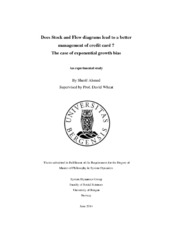| dc.description.abstract | Abstract Exponential growth bias is the tendency to linearize exponential functions. It means that people underestimate the future value of a growing debt in case of borrowing and future value of a growing investment in case of saving .The bias matters empirically by making consumers have a great tendency to ignore the returns generated by compounding .Consequently, consumers who are biased tend to borrow more and save less. This study aims to provide a toolkit to debias the tendency to underestimate exponential growth variables and helping people to make better financial decision. We investigated the effect of using stock and flow diagram as external visualization tool for financial problems on perceiving variables that grow exponentially. In the experiment, we gave three credit card problems for two groups each consisting of seven participants. A treatment group which was provided with a stock and flow diagram explaining those problems in addition to compounding formulas. A control group which was provided with only the compounding formulas. Through a bi dimensional statistical analysis, we tried to assess the bias in term of the magnitude and the direction .We found that both groups underestimate the required time to pay-off a debt. Meanwhile the experimental group overestimated the payment amount in order to pay-off the card debt in three years and overestimated the remaining balance on the card after twenty years of paying a certain amount of monthly payment. The qualitative analysis of participants methods for obtaining the answers showed that participants in both groups anchor to the required time to pay off the principle of the debt when they try to calculate the required time to pay-off the interest .Stock and flow diagram was useful in obtaining a better mental model by taking into account the accumulation of the interest every year. However, participants in both groups found difficulties when they tried to iii calculate a declining stock problem .That made the experimental group overestimate the required monthly payment to pay-off the debt. Furthermore, experimental group was better in considering the consequences of the reinforcing loop between the debt and the interest in the long-term while most of control group participants underestimated the remaining balance of debt .Further research and limitations have been discussed. Keywords: System dynamics, system thinking, Exponential growth bias, Stock and flow diagrams, credit card usage, Credit card | en_US |
